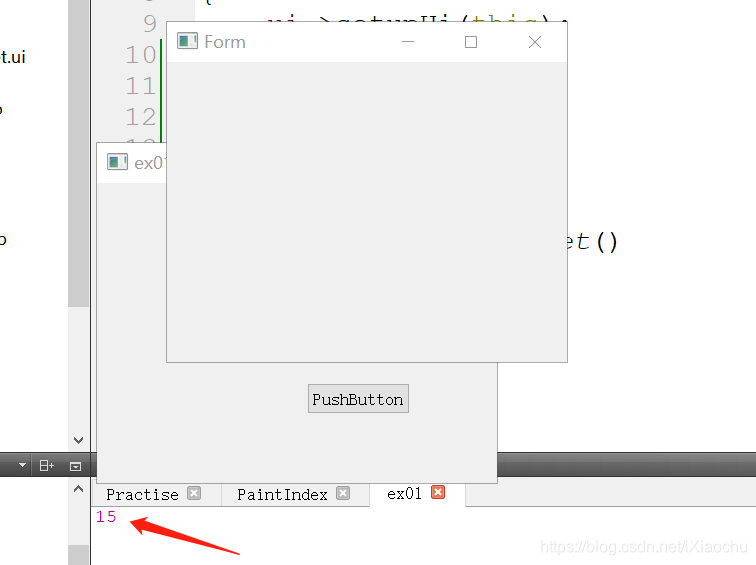前言
为了的可读性和移植性,我们可能需要将一个CPP文件拆分成多个文件,这时,如果在一个.cpp文件中想调用另一个.cpp中的变量该如何操作?
具体步骤
1、新建不同的.cpp项目工程文件
这里面原始参数放在ex01中,new_widget用于调用原始参数。

2、在ex01.cpp中声明一个外部变量
注意:外部变量extern要放在最开始,一定不要放在class类中,否则会报错:storage class specified for 'XXX(变量名)'

3、在ex01.cpp中定义该变量

至此,该变量的声明和定义工作已经完毕,在其他.cpp文件中,例如new_widget.cpp中,如果想调用该变量,则引用一下extern即可。
4、在其他.cpp文件中调用原始变量

注意事项
要注意区分“声明”和“定义”之间的区别:
根据C++标准的规定,一个变量声明必须同时满足两个条件,否则就是定义:
(1)声明必须使用extern关键字;
(2)不能给变量赋初值
extern int a; //声明
int a; //定义
int a = 0; //定义
extern int a = 0; //定义
- 1
- 2
- 3
- 4
- 5
- 6
- 7
完整源代码
ex01.h
#ifndef EX01_H
#define EX01_H
#include <QWidget>
#include “new_widget.h”
extern int a;
namespace Ui {
class ex01;
}
class ex01 : public QWidget
{
Q_OBJECT
public:
explicit ex01(QWidget *parent = 0);
~ex01();
private:
Ui::ex01 *ui;
private slots:
void Slot_open_widget();
};
#endif // EX01_H
- 1
- 2
- 3
- 4
- 5
- 6
- 7
- 8
- 9
- 10
- 11
- 12
- 13
- 14
- 15
- 16
- 17
- 18
- 19
- 20
- 21
- 22
- 23
- 24
- 25
- 26
- 27
- 28
- 29
new_widget.h
#ifndef NEW_WIDGET_H
#define NEW_WIDGET_H
#include <QWidget>
namespace Ui {
class new_widget;
}
class new_widget : public QWidget
{
Q_OBJECT
public:
explicit new_widget(QWidget *parent = 0);
~new_widget();
private:
Ui::new_widget *ui;
};
#endif // NEW_WIDGET_H
- 1
- 2
- 3
- 4
- 5
- 6
- 7
- 8
- 9
- 10
- 11
- 12
- 13
- 14
- 15
- 16
- 17
- 18
- 19
- 20
- 21
- 22
- 23
ex01.cpp
这里我做了一个新窗口的弹出widget->show();,不然的话显示不了qDebug()的内容
#include "ex01.h"
#include "ui_ex01.h"
int a = 15;
ex01::ex01(QWidget *parent) :
QWidget(parent),
ui(new Ui::ex01)
{
ui->setupUi(this);
connect(ui->pushButton,SIGNAL(clicked(bool)),this,SLOT(Slot_open_widget()));
}
void ex01::Slot_open_widget()
{
new_widget *widget = new new_widget();
widget->show();
}
ex01::~ex01()
{
delete ui;
}
- 1
- 2
- 3
- 4
- 5
- 6
- 7
- 8
- 9
- 10
- 11
- 12
- 13
- 14
- 15
- 16
- 17
- 18
- 19
- 20
- 21
- 22
- 23
- 24
- 25
new_widget.cpp
#include "new_widget.h"
#include "ui_new_widget.h"
#include <QDebug>
new_widget::new_widget(QWidget *parent) :
QWidget(parent),
ui(new Ui::new_widget)
{
ui->setupUi(this);
extern int a;
qDebug() << a;
}
new_widget::~new_widget()
{
delete ui;
}
- 1
- 2
- 3
- 4
- 5
- 6
- 7
- 8
- 9
- 10
- 11
- 12
- 13
- 14
- 15
- 16
- 17
- 18
- 19
运行结果如图## 标题:

https://blog.csdn.net/weixin_33119123/article/details/113412137
在一个cpp文件里访问另一个cpp的全部变量_C++理论梳理3——深刻理解头文件的作用…
c++工程里一个文件怎么调用另外一个文件里的函数
(1)前提为,另一个文件中的函数,不能是静态函数,即不能有static修饰。
调用方法,在调用前进行声明,然后直接调用即可。
声明方法:
1 直接在调用前,写函数声明:
如调用函数为int func(int a),那么在调用前只需要
int func(int a);
这样声明后,即可使用func。
2 将声明写在头文件中。
如在名为func.h的头文件中加入
int func(int a);
然后在调用的源文件中,引用
#include “func.h”
即可调用func。
(2)举个例子吧:两个文件 main.c function.c
我们在function.c 中写一个函数 func();
与此同时,我们需要写一个.h文件来声明这个函数,即function.h
// 以下是function.h 的内容
#ifndef FUNCTION_H
#define FUNCTION_H
void func();
#endif
// 以下是function.c 的内容
#include “function.h”
void func()
{
// do something
}
这样一来,我们想要在另外一个文件,也就是main.c 中调用这个函数的时候,只需要包含它对应的头文件,就可以直接调用了。
// 以下是main.c 的内容
#include “stdio.h”
#include “function.h”
int main()
{
func();
return 0;
}





















 4032
4032











 被折叠的 条评论
为什么被折叠?
被折叠的 条评论
为什么被折叠?








